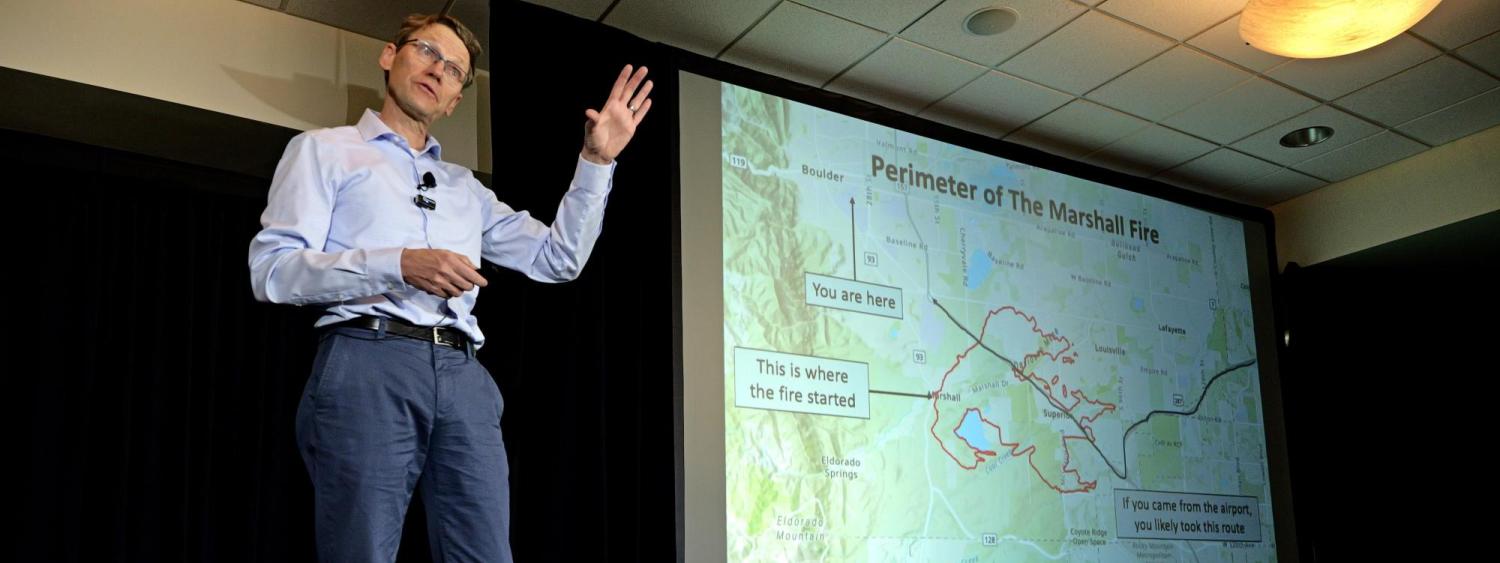
Joost de Gouw, an atmospheric scientist with the Cooperative Institute for Research in Environmental Science (CIRES) presents at Science Writers 23 at CU Boulder. (Photo by Casey A. Cass/University of Colorado)
Nearly two years after the devastating Marshall Fire, many residents are still recovering and questions remain about air quality in scorched neighborhoods and smoke-drenched homes.
In homes that were spared by fire, some homeowners still found thick layers of ash and soot along with a strong burn smell when they returned home after being evacuated.
"Many people didn't move back home for weeks and months," said Joost de Gouw, fellow at the Cooperative Institute for Research in Environmental Sciences (CIRES) at CU Boulder and professor of chemistry. "Some people didn't go back at all, because they didn't feel safe."
De Gouw described his team's research into indoor air quality issues after the fire as a panelist at an annual science writing conference earlier this week co-hosted by CU Boulder and CU Anschutz.
The wildfire erupted late morning of December 30, 2021, first as a grass fire in a location south of Boulder. Fueled by hurricane-force winds, the fire spread quickly eastward, reaching the nearby towns of Superior and Louisville and gobbling up more than 900 houses in the span of 12 hours. The fire killed two people and burned 1,084 buildings in total.
Initially, de Gouw and his team were not planning on studying the fire's impacts because they thought people would not want researchers to poke around in the aftermath of a tragedy. Instead, residents had a lot of questions and wanted answers.
"They wanted to know what's in the air they are breathing and whether it's safe to go back home," de Gouw said.
When the team started looking into the scientific literature on indoor air quality after fires, they found the existing data was insufficient to answer these questions.
To fill the knowledge void, the team deployed measuring devices in people's homes to collect data on what's in the air. Initially supported by a small rapid-turnaround grant from CIRES and then a larger one from the National Science Foundation, the team found a high level of volatile organic compounds (VOCs), which are air pollutants that have been linked to a variety of health problems, in homes affected by wildfire smoke. To the researchers' surprise, the levels of indoor VOCs took about six weeks after the fire to return to normal. This is significantly longer than what it took for VOCs emitted by other sources to disperse in de Gouw's previous studies.
"The Marshall fire started as a grass fire and turned into an urban fire," he said. "What it burned was primarily buildings instead of vegetation as seen in many other wildfires."
This is important because the burning of building materials releases a unique set of air pollutants compared to fires that burn mainly vegetation.
"We are still trying to figure out why it took so long, but these chemicals brought by smoke can apparently penetrate deep into a home's structure," de Gouw said, adding that people found blackened insulation materials behind their walls after the fire.
The levels of particulate matter in these smoke-affected homes were generally low, but the ash and soot on the floor and furniture could be resuspended in the air when the homes were cleaned. During cleaning, the team recorded large spikes in particulate matter levels that could have negative health impacts if inhaled.
As the community gradually recovers, de Gouw's research continues. He and his team are currently working with researchers from Colorado State University to study how burning materials - including furniture, roofing and electrical wires - may contribute to the release of toxic chemicals.
De Gouw emphasized the difficulty in communicating about ongoing scientific research, especially when people have experienced trauma and are concerned about health impacts to themselves and loved ones.
"You know there's the need for information out there and you would like to give people assurances, but you also don't want to assure them if it's not based on good data," de Gouw said. "That's an incredibly difficult thing to do."
Science Writers 2023 is an annual conference of the National Association of Science Writers and the Council for the Advancement of Science Writing. This year's conference was attended by more than 600 science journalists and communicators.






